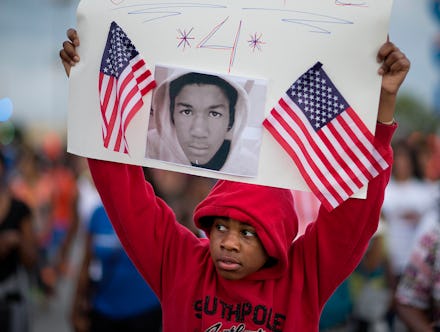It's Been 3 Years Since Trayvon Martin's Death — Here's What We've Learned

Three years ago yesterday, George Zimmerman stalked 17-year-old Trayvon Martin through a gated community in Sanford, Florida, and then shot him through the heart. Earlier this week, the U.S. Department of Justice declined to file civil rights charges against the killer, two years after a state court acquitted him of murder.
A lot happened between those benchmarks. Conversations about police officers or vigilantes targeting black Americans have reached a turning point, dominating national headlines with each tragic new development, including the deaths of Eric Garner and Michael Brown.
But Martin's killing also laid bare the mechanisms of institutional racism that persist in this country. Through the following lessons, the disparate treatment of black victims in our society became startlingly clear, forcing Americans to re-evaluate long-held notions of race, innocence, criminality and self-defense.
Clothing is probable cause.
FOX News contributor Geraldo Rivera famously blamed Zimmerman's aggression on the fact that Martin was wearing a hoodie at the time of his death. Since then, the common, yet racially coded, clothing item has faced bans everywhere from Brooklyn to Oklahoma.
It's also been re-appropriated as a symbol of protest by the Million Hoodies organization, the NBA's Miami Heat and others. But the real tragedy is that a sweatshirt — when linked to a narrative of young black men as thugs and criminals — was used to justify murder to begin with.
Post-mortem smear campaigns are the new black.
A large part of Zimmerman's defense hinged on painting Martin as a weed-smoking hoodlum with a history of delinquency. This was hardly the only time a young black man's behavior was used to justify his murder; the media's portrayal of Michael Brown was so biased by his assumptions about his past it inspired a Twitter hashtag, #IfTheyGunnedMeDown, highlighting the tendency to criminalize unarmed black people even after their deaths.
That these victims were thrown so readily under suspicion is a troubling sign of systemic racial bias.
The police are not your friends.
Martin was killed by a vigilante of sorts, as was Jordan Davis soon after in Florida. But the names we most widely associate with the recent wave of violence against black Americans — names like Michael Brown, Eric Garner, John Crawford III and Tamir Rice — have one thing in common: Their killers were all police officers.
Meanwhile, George Zimmerman was released by police just hours after killing Martin because they claimed they couldn't find "probable cause" that he'd committed a crime, according to the Tampa Bay Times. Their evidence consisted largely of Zimmerman's own testimony, which included the claim that he'd acted in self-defense.
Such behavior casts serious doubt on the police mandate to protect and serve all citizens equally.
Murder might be legal if you're "standing your ground."
In 2012, 24 states had laws like Florida's "stand your ground" law on the books, according to ProPublica. These laws relieves people of the duty to retreat if they feel threatened, and grant them some legal immunity in the name of self-defense.
They were also used to acquit George Zimmerman, who by all accounts initiated contact with the boy he later killed in "self-defense," in defiance of explicit police instructions. If a law can be used to justify Zimmerman killing a teenager, it seems logical to reconsider its efficacy.
Killing is profitable.
Before his multiple domestic violence and assault arrests, George Zimmerman was using his post-acquittal fame to bolster his career as a painter. In December 2013, he sold a piece for over $100,000 on eBay, while his family tried leveraging his notoriety into lucrative television appearances and a reality TV show, according to a GQ profile.
Not one year later, Ferguson, Missouri, police Officer Darren Wilson killed unarmed black teenager Michael Brown. His punishment? Months of paid administrative leave and over $400,000 raised through a GoFundMe account to support his legal defense. It's hard to imagine either monetary opportunities arising if these men hadn't recently killed black teens in "self-defense."
Activism is not dead.
There is hope, however. The wave of protests that started after Martin's death exploded into a nationwide movement after Ferguson, bringing #BlackLivesMatter to the forefront of the national conversation. What's more, it's driven by young people, actively debunking myths of millennial apathy and political non-involvement.
Neither is solidarity.
In a letter published in Time, Sybrina Fulton, mother of Martin, delivered a message of support to Lesley McSpadden, mother of Michael Brown.
"I wish I had a word of automatic comfort, but I don't," she wrote, continuing:
"I wish I could say that it will be all right on a certain or specific day, but I can't. I wish that all of the pain that I have endured could possibly ease some of yours, but it won't. What I can do for you is what has been done for me: pray for you then share my continuing journey as you begin yours.
That one mother had to write this letter to another — and under such tragic circumstances — is the ultimate indication that America's treatment of black lives is disproportionately defined by violence and devaluation.
Trayvon Martin made us talk about this phenomenon with unprecedented fervor and focus. How long the conversation continues is up to us.